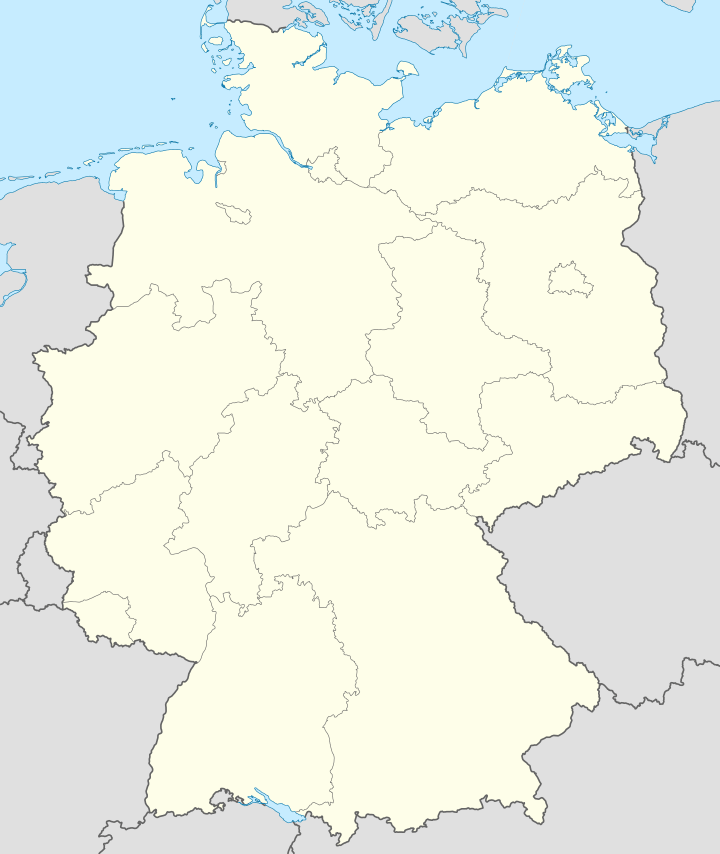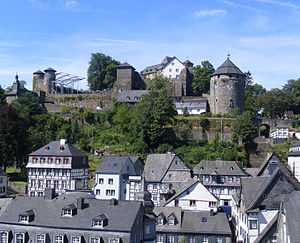Monschau
| Monschau | ||
|---|---|---|
|
Slate-roofs of Monschau town centre and castle. The castle's courtyard in preparation for Monschau Open Air Klassik music festival | ||
| ||
 Monschau | ||
Location of Monschau within Aachen district  | ||
| Coordinates: 50°33′36″N 06°15′23″E / 50.56000°N 6.25639°ECoordinates: 50°33′36″N 06°15′23″E / 50.56000°N 6.25639°E | ||
| Country | Germany | |
| State | North Rhine-Westphalia | |
| Admin. region | Köln | |
| District | Aachen | |
| Government | ||
| • Mayor | Magga Ritter (CDU) | |
| Area | ||
| • Total | 94.620312003 km2 (36.533106706 sq mi) | |
| Population (2013-12-31)[1] | ||
| • Total | 11,866 | |
| • Density | 130/km2 (320/sq mi) | |
| Time zone | CET/CEST (UTC+1/+2) | |
| Postal codes | 52156 | |
| Dialling codes | 02472 | |
| Vehicle registration | AC / MON | |
| Website | www.monschau.de | |
Monschau (French: Montjoie, Walloon: Mondjoye) is a small resort town in the Eifel region of western Germany, located in the district Aachen, North Rhine-Westphalia.
Geography
The town is located in the hills of the North Eifel, within the Hohes Venn – Eifel Nature Park in the narrow valley of the Rur river.
The historic town center has many preserved half-timbered houses and narrow streets have remained nearly unchanged for 300 years, making the town a popular tourist attraction nowadays. An open-air, classical music festival is staged annually at Burg Monschau. Historically, the main industry of the town was cloth-mills.
History
On the heights above the city is Monschau castle, which dates back to the 13th century — the first mention of Monschau was made in 1198. Beginning in 1433, the castle was used as a seat of the dukes of Jülich. In 1543, Emperor Charles V besieged it as part of the Geldern Feud, captured it and plundered the town. However, the castle stayed with Jülich until 1609, when it became part of Palatinate-Neuburg.
In 1795, the French captured the area and, under the name Montjoie, made it the capital of a canton of the Roer département. After the area became part of the Kingdom of Prussia in 1815, Monschau became the district capital of the Kreis Montjoie.
During World War I, some people argued that Monschau (or "Montjoie" as it was then still called) should be annexed to Belgium since they believed it historically to be a Walloon area that had been Germanized by the Prussians.[2]
In 1918, William II, German Emperor, changed the name to Monschau. In 1972, the town was enlarged with the previous independent municipalities of Höfen, Imgenbroich, Kalterherberg, Konzen, Mützenich and Rohren. Mützenich, to the west of the town center, is an exclave of German territory surrounded by Belgium. It is separated from Germany by a railroad line that was assigned to Belgium by the Treaty of Versailles in 1919.
During World War II the town of Monschau, sitting on a vital road network, was a point of great tactical importance in the opening phase of the Battle of the Bulge in December 1944.[3]
Notable residents
- Karl Wilhelm Scheibler (1820–1881), industrialist.
- Elwin Bruno Christoffel (1829–1900), physicist and mathematician.
Gallery
-
Historic center of Monschau at the Rur
-
Street in Monschau
-
Another street in Monschau
-
Church on a square
-
Eastern walls of the castle of the Dukes of Jülich (13th century).
-
Protestant Church in Monschau with the tower removed
References
- ↑ "Amtliche Bevölkerungszahlen". Landesbetrieb Information und Technik NRW (in German). 4 September 2014.
- ↑ Finot, Jean. New York Times, May 30th, 1915
- ↑ Cole, Hugh M. (1965). THE ARDENNES: BATTLE OF THE BULGE (LC: 65-60001 ed.). Washington, D.C.: OFFICE OF THE CHIEF OF MILITARY HISTORY DEPARTMENT OF THE ARMY. p. 86.
External links
![]() Media related to Monschau at Wikimedia Commons
Media related to Monschau at Wikimedia Commons
- Official site (German) (English)
- Official site of Monschau Music Festival (German)
- Official site for the borough of Höfen (German)
| ||||||||







